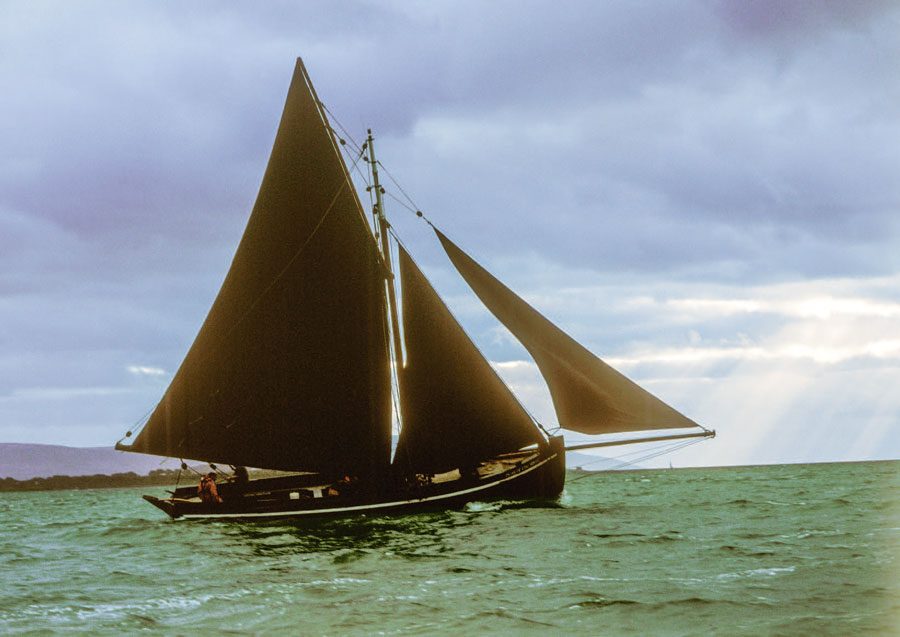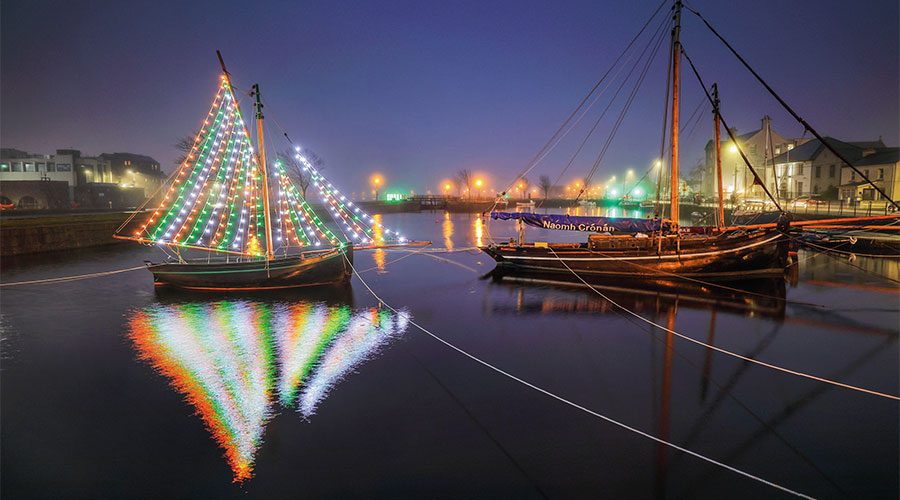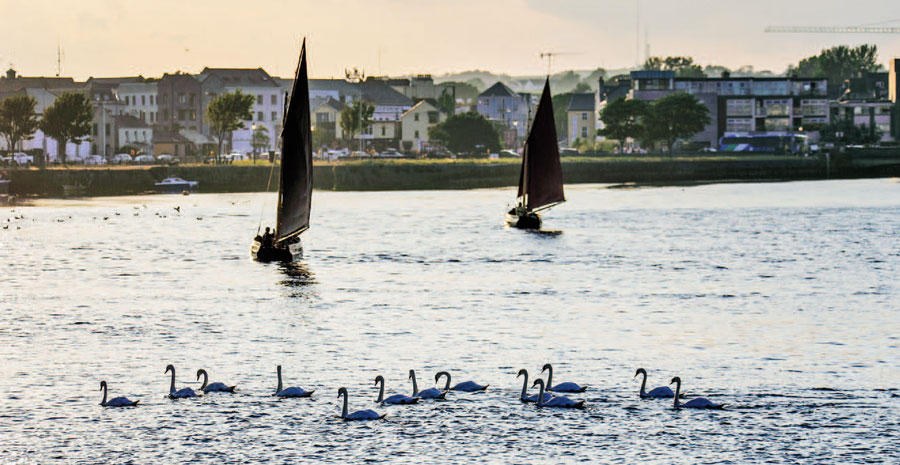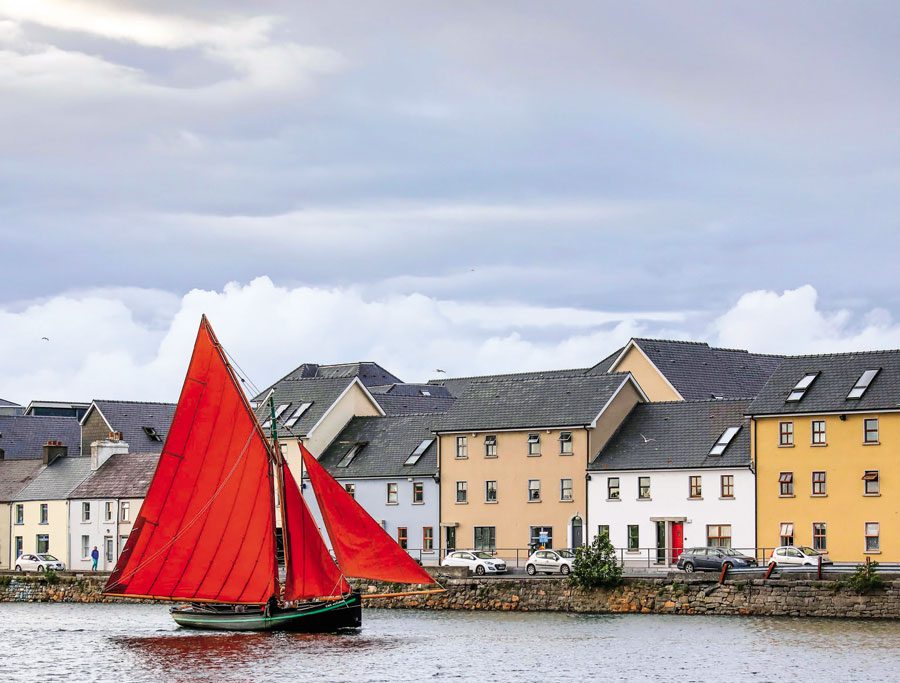

It started well but danced around the engine compartment in a most alarming manner, so we sailed between the big breakwaters into Dun Laoghaire harbour, past the yachts straining at their moorings off the yacht club and into the ‘coal harbour’ at the western end where the fishing boats berthed.
We ran out of wind in the lee of an ice plant and coasted in until the way came off so I dropped the anchor and began unlashing the dinghy to row a line ashore.
Two fishermen were working on a net which hung from a gilson, or derrick off the mast. One walked a couple of paces to the wheelhouse, took a lifering from its bracket, tied netting twine from a spool onto it, and heaved it in our direction.

A Hooker under full sail.
Wind and tide carried it down until I could pick it up with a boathook. I tied a mooring line to it and he turned away from his work again to pull it in, untie our line and transfer it to his forward bollard.
By the time I’d pulled alongside and made her fast, the men had retired belowdecks and I knocked on the wheelhouse door to thank them.
“You’ll be right, boyo,” they replied, “you’ll be nice and snugged up now to be sure. And there’d be a couple of fishes wrapped in that newspaper there.”
For a few days we lay in the coal harbour while I sourced new engine mounts. In the morning I’d pull the boat back to let the trawler out, pull back into their berth for the day and warp the boat out again so it would be free when they returned from the day’s fishing.

The picturesque town of Galway with its prominent cathedral.
Our cat grew plump and glossy on a diet of fish livers and titbits he cadged from the men as they cleaned their catch.
Then one day, at the information office, I saw the poster saying: ‘Galway Bay Hooker Regatta’ with a date.
I asked Padraic, from the boat next door, what a hooker was. “Weell, I’m not really certain, to be sure, I tinks they’s auld work boats from the west…”
‘Old boat from the west,’ sounded like me. I love old wooden workboats sailed hard by working sailors and fishermen. I’d sailed on Bahamian conch skiffs and turtle boats in Anguilla… why not hookers in Ireland?
The next day we left our boat and cat in the care of the fishermen and boarded a bus bound for Ireland’s wild Atlantic coast.

Claddagh pulled up on the beach, a popular subject with photographers.
The bus wheezed through villages of squat stone houses and rolling paddocks hemmed with dry stone walls and as we crested a hill to roll into Galway almost every second one of the houses lining the road had a B&B sign prominently on show in a front window.
They seemed like doll houses as the mysticism of Ireland’s west coast seeped into us. A leprechaun could have skipped across the road in front of the bus and we wouldn’t have thought anything of it.
In Galway, half a dozen hookers were clustered in the wee rock-walled harbour and men in tweed jackets and cloth caps rove ropes and did last minute jobs.
“G’day,” I asked, “my names Lindsay from New Zealand – does anyone need a hand for the regatta?”
“Yeah boy,” one man replied – “ye can come along wi’ us.”

Hookers and other traditional working boats lit up in Galway Harbour.
Next day I turned up bright and early, grasped a rope shroud and swung down onto the deck. “What do you want me to do?”
The skipper man regarded me thoughtfully through a thatch of bushy eyebrows, and rubbed his head with a handful of his tweed hat. Woollen threads sprouted from the holed elbows of his tweed jacket and a baggy pair of corduroy trousers fell down to a pair of scuffed brogues.
“Weell boy,” he said finally, “ye’ll be on de rocks, to be sure.”
Beaut, I thought, sounds like a good job – though I wasn’t exactly sure what or where the rocks were.
 Hookers and geese. Note the vessels’ extreme tumblehome.
Hookers and geese. Note the vessels’ extreme tumblehome.
Galway Bay hookers evolved when there was no port in the bay. Freighters anchored in the roads and discharged their cargo to and from lighters – which became known as “hookers.” The crews were paid per trip so the fastest boats earned most – they raced all day for as long as the cargo needed unloading.
Over several hundred years their lines evolved to suit the work and typically, hookers have a near plumb, slightly rounded stem; a cod’s head and mackerel tail waterline shape with the maximum beam well forward, extreme tumblehome and the rudder raked about 40o inwards.
Most of them had larch planking fastened to white oak frames with big galvanised boat nails. Douglas fir from the north of Ireland is also used for some structural members and masts. Then the whole boat was ‘painted,’ inside and out, with tar….which quickly transferred itself to any clothing that came in contact with it.
But, there’s no other boat quite like a hooker.
 Popular with tourists, Ireland’s west coast is home to many traditional wooden boats.
Popular with tourists, Ireland’s west coast is home to many traditional wooden boats.
They come as either baid mohra (big hookers), Leith bhaid (half hookers), gleoieogai (medium hookers) and pucain (small single-sail hookers with dipping lug mainsail). Latterly they were used to carry cargos of hay, livestock and peat to and from the offshore islands, or for fishing.
I’d chanced on a half-hooker, An Reamon, about 9.8m long on deck, 3.5m on the beam, a draught of about one metre, with a big gaff mainsail and jib tacked at the end of her retracting bowsprit.
‘The rocks’ were ballast, neatly stacked in the bilge and my job for the weekend would be to move them from side to side as we tacked. They weighed roughly 10kg each but got heavier as the day wore on.
The rest of the crew began arriving, all attired in worn tweed jackets and knitted vests and mostly armed with flasks of Jameson’s whiskey.
 Ireland’s west coast is stunningly beautiful.
Ireland’s west coast is stunningly beautiful.
Dermot, the skipper, took the long tiller and another old man sat on a board next to him. The boat developed huge weather helm and the second man’s role was to trim the mainsheet and put his back into the tiller. These two were also sailing masters and tacticians.
My role was to move rocks and I’m sure that the seafaring people of Galway Bay must still be laughing about the Kiwi who spent the regatta on the rocks.
“OK boys,” Dermot would say quietly and that was my cue to start pulling rocks out of the windward bilge. As she came into the wind and the big mainsail slapped and cracked above me, I’d move more frantically, placing the rocks so they wouldn’t move if we took a knockdown. Originally sacks of sand were also used in heavy weather because they got heavier as they absorbed water. And pig iron ingots or concrete blocks.
Then, as we filled away on the new tack, I’d place the last of the rocks, stretch my back and perch along the weather rail among my crewmates. Flasks would be held out in my direction and, as the whiskey rolled down my throat smiles would break out all round. Every man there had done his turn on the rocks.
 A Galway Bay Hooker outward bound.
A Galway Bay Hooker outward bound.
“We’ll be coming off the wind soon, to be sure – could you pull some of those rocks back from forward of the mast and set ‘em back here at the stern,” Dermot said, but pretty soon I came to anticipate our moves and move the rocks accordingly.
We were second boat round the course; out of the bay, round a buoy laid in the former freighter anchorage and back up the bay.
And in the pub that night I was introduced as “the fella from New Zealand who was on the rocks.” Wives and girlfriends looked at me with greater respect….well, in my head anyway.
We ran a closer second place the next day and spent a couple of hours on board, putting our boat to bed, drinking whiskey and ‘debriefing.’
My back ached and I felt like a human hairpin…. but the racing had been great. Not particularly fast, but fun, and anyway, it doesn’t really matter what you race as long as you race it as hard as you can.
We’d raced hard and Dermot clasped my hand to help me onto the dock. “Yer did well,” he said, “will yer be around for next year’s racin’?
“But I won’t put yer on the rocks.” BNZ




